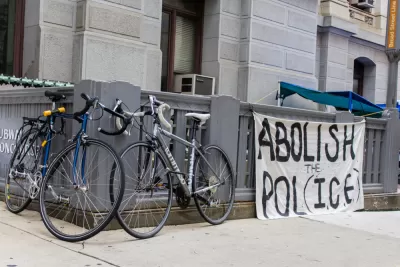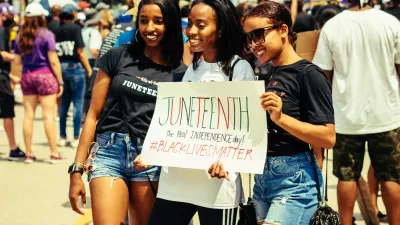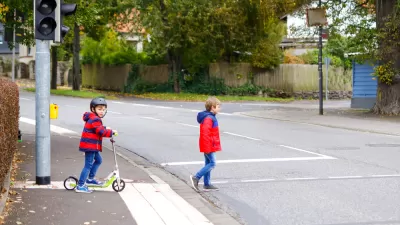Abolition—as a mode of mobilization and social change directed at the criminal legal system and elsewhere—remains widely misunderstood.

It’s hard to overstate the transformation in the politics of public safety over the course of 2020. After the murder of George Floyd and corresponding uprising in Minneapolis, a nationwide movement of unprecedented scale arose to grieve and to resist anti-Black racism. The Overton window on policing shifted rapidly: community-based accountability and notions of #CareNotCops entered the mainstream as credible alternatives to incarceration, and centrist leaders once content with criminal justice reform began to speak of defunding and even abolishing the police. The groundswell in the streets turned the tide in halls of power. Long-standing demands to identify and uproot the carceral state’s connections to chattel slavery are finally being heard and heeded.
This kind of sea change is overdue in housing policy, where incremental, rather than transformative, approaches have traditionally been the norm despite visionary contributions from housing activists. The exigencies of 2020 require a bold, new course. Both the severity of pandemic-spurred rental arrears and the might and potential of the Movement for Black Lives urge a different way forward. As we argue in a new paper, the movements for prison and police abolition offer vital lessons for housing justice.
Linking Abolition and Housing Justice
Engaging with abolitionism would first entail envisioning what housing justice would look like in abolition democracy. The voices of residents and of grassroots movements should be central to this vision, but we might imagine that housing justice encompasses, at minimum, ample safe and affordable housing; abundant wealth-building opportunities for Black households and communities; and a severing of the link between geography and opportunity. Abolition then asks what foundational conditions are necessary to make such a world possible and suggests that we should direct resources toward those ends. Research documenting the conditions of “high-opportunity” neighborhoods—today inhabited primarily by affluent white households—is instructive here. Access to food, jobs, and health care; well-resourced schools and libraries; and parks and green spaces can be foundational conditions for housing justice. Going deeper, we might imagine that such a world also requires investment in services that would address the root causes of or otherwise provide meaningful treatment for substance abuse, domestic violence, and mental health concerns.
Abolition is, in the words of scholar and activist Angela Davis, “not only, or not even primarily . . . a negative process of tearing down.” Nevertheless, abolition also compels us to imagine the obsolescence of institutions that fail to serve their designated purpose, prove resistant to reform, and perpetuate oppression. Just as prison and police abolitionists operate in pursuit of a world in which prisons and police are not only nonexistent but obsolete, we might ask: What would it take to make eviction, emergency shelter, or similar institutions unnecessary?
Consider, for example, housing court through an abolitionist lens. In theory a forum in which landlords and tenants can each vindicate their rights, housing courts instead . . .
FULL STORY: What’s Abolitionist Housing Policy?

Alabama: Trump Terminates Settlements for Black Communities Harmed By Raw Sewage
Trump deemed the landmark civil rights agreement “illegal DEI and environmental justice policy.”

Planetizen Federal Action Tracker
A weekly monitor of how Trump’s orders and actions are impacting planners and planning in America.

The 120 Year Old Tiny Home Villages That Sheltered San Francisco’s Earthquake Refugees
More than a century ago, San Francisco mobilized to house thousands of residents displaced by the 1906 earthquake. Could their strategy offer a model for the present?

In Both Crashes and Crime, Public Transportation is Far Safer than Driving
Contrary to popular assumptions, public transportation has far lower crash and crime rates than automobile travel. For safer communities, improve and encourage transit travel.

Report: Zoning Reforms Should Complement Nashville’s Ambitious Transit Plan
Without reform, restrictive zoning codes will limit the impact of the city’s planned transit expansion and could exclude some of the residents who depend on transit the most.

Judge Orders Release of Frozen IRA, IIJA Funding
The decision is a victory for environmental groups who charged that freezing funds for critical infrastructure and disaster response programs caused “real and irreparable harm” to communities.
Urban Design for Planners 1: Software Tools
This six-course series explores essential urban design concepts using open source software and equips planners with the tools they need to participate fully in the urban design process.
Planning for Universal Design
Learn the tools for implementing Universal Design in planning regulations.
Clanton & Associates, Inc.
Jessamine County Fiscal Court
Institute for Housing and Urban Development Studies (IHS)
City of Grandview
Harvard GSD Executive Education
Toledo-Lucas County Plan Commissions
Salt Lake City
NYU Wagner Graduate School of Public Service





























